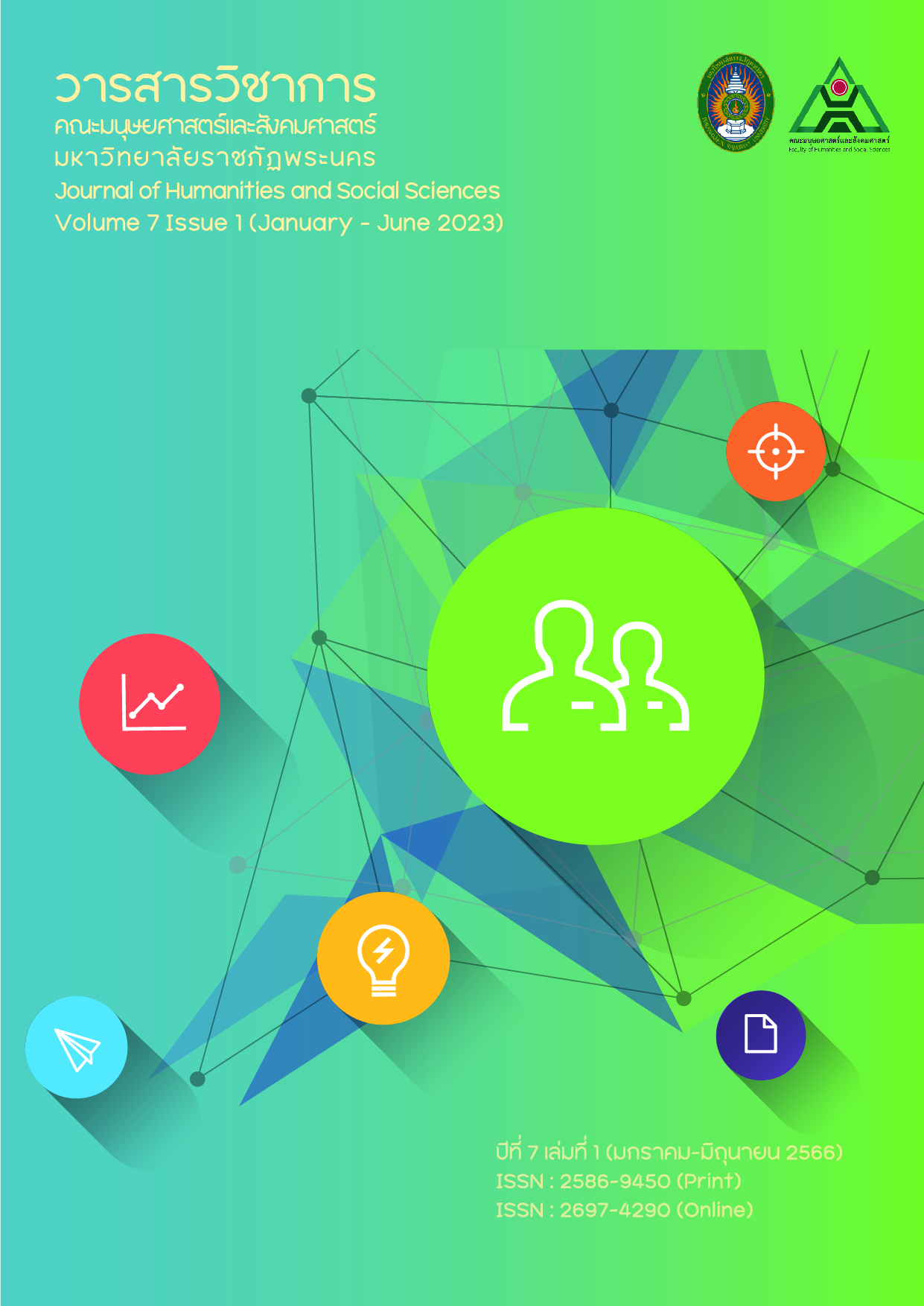การพัฒนาการคิดเชิงวิพากษ์วิชาคณิตศาสตร์ผ่านกระบวนการการแก้โจทย์ปัญหา
Main Article Content
บทคัดย่อ
งานวิจัยฉบับนี้มีวัตถุประสงค์เพื่อเปรียบเทียบทักษะการคิดเชิงวิพากษ์ก่อนเรียนและหลังเรียนในวิชาคณิตศาสตร์โดยผ่านการเรียนรู้จากการแก้ไขโจทย์ปัญหา และศึกษาความคิดเห็นของนักเรียนที่มีต่อการใช้รูปแบบการคิดเชิงวิพากษ์ในวิชาคณิตศาสตร์ โดยใช้กลุ่มตัวอย่างคือนักเรียนโรงเรียนนานาชาติแองโกสิงคโปร์ ชั้นประถมศึกษาปีที่ 4 จำนวน 30 คน ประจำปีการศึกษา 2564-2565 ผู้วิจัยเก็บข้อมูลเชิงปริมาณและเชิงคุณภาพ โดยให้นักเรียนทดสอบก่อนการเรียน หลังจากนั้นใช้กระบวนการคิดเชิงวิพากษ์ในวิชาคณิตศาสตร์ระหว่างเรียนและทำการทดสอบหลังเรียนอีกครั้ง นำผลคะแนนการทดสอบก่อนและหลังเรียนมาเปรียบเทียบ ผลลัพธ์คือคะแนนค่าเฉลี่ยหลังการเรียนมีค่าเท่ากับ 7.26 และส่วนเบี่ยงเบนมาตรฐาน 1.11 และการทดสอบก่อนเรียนได้ผลเฉลี่ยคือ 4.26 และส่วนเบี่ยงเบนมาตรฐาน 1.11 ผลสัมฤทธิ์ของการทดสอบ ก่อน-หลัง เป็นที่น่าพอใจ อย่างมีนัยสำคัญทางสถิติที่ระดับ 0.01 จากผลลัพธ์แสดงให้เห็นว่าการใช้กระบวนการคิดเชิงวิพากษ์ในวิชาคณิตศาสตร์ทำให้นักเรียนมีพัฒนาการที่ดีขึ้น และด้านความคิดเห็นของนักเรียนที่มีต่อการเรียนโดยใช้รูปแบบการคิดเชิงวิพากษ์ซึ่งผู้วิจัยใช้การสัมภาษณ์เป็นรายบุคคลรวมทั้งใช้การประเมินจากแบบสอบถามความคิดเห็นของนักเรียน ผลวิจัยพบว่านักเรียนมีความคิดเห็นเชิงบวกต่อการเรียนโดยการใช้วิธีคิดเชิงวิพากษ์ในวิชาคณิตศาสตร์ ดังนั้นแนวทางการเรียนรู้โดยใช้การคิดเชิงวิพากษ์ในวิชาคณิตศาสตร์จึงถือได้ว่าเป็นประโยชน์ในการเรียนรู้คณิตศาสตร์และพัฒนาทักษะการคิดเชิงวิพากษ์ของผู้เรียน
Article Details
เอกสารอ้างอิง
Allen, E. K., & Cowdery, G. E. (2014). The exceptional child: Inclusion in early childhood education. Nelson Education.
Anderson, C. (2018, July 3). Connecting Universal Design for Learning With Culturally Responsive Teaching. Education and Urban Society, 51(9), 1202–1216. https://doi.org/10.1177/0013124518785012
Banes, B. C. (2013). A study of preservice elementary teachers learning mathematics through problem-based learning and problem solving. UMI Dissertation Publishing.
Banes, B. & Miller, L. D. (2012). Teaching preservice elementary teachers mathematics through problem-based learning experiences and problem solving (pp. 5532- 5539). In Proceedings of the International Congress on Mathematical Education. Seoul, Korea.
Bellanca, J. A. (2011). 21st century skills: Rethinking how students learn. Solution Tree Press.
Cass, M., Cates, D., Smith, M., & Jackson, C. (2003, May). Effects of Manipulative Instruction on Solving Area and Perimeter Problems by Students with Learning Disabilities. Learning Disabilities Research and Practice, 18(2), 112–120. https://doi.org/10.1111/1540-5826.00067
Dewey, J. (1910). How we think. Boston, MA: D. C. Heath & Co. Retrieved from http://tinyurl.com/l6q46mq
Dewi, A. K., Slamet, S. Y., Surya, A., & Syawaludin, A. (2020). Thailand elementary school students’ critical thinking skills in mathematics education. Journal of Physics: Conference Series, 1511, 012047.
Duron, R., Limbach, B., & Waugh, W. (2006). Critical thinking framework for any discipline. International Journal of Teaching and Learning in Higher Education, 17(2), 160-166.
Fisher, A. (2011). Critical thinking: An introduction. Cambridge University Press.
Galinsky, E. (2010). Mind in the making: The seven essential life skills every child needs. New York: Harper Collins Publishing.
Golafshani, N. (2003). Understanding reliability and validity in qualitative research. The Qualitative Report, 8(4), 597-600.
Hambleton, R. K., & Cook, L. L. (1977). Latent Trait Models and Their Use in the Analysis of Educational Test Data. Journal of Educational Measurement, 14(2), 75–96.
Hmelo-Silver, C. E. (2004). Problem-based learning: What and how do students learn? Educational Psychology Review, 16, 235-266.
Jones, C., & Pimdee, P. (2017). Innovative ideas: Thailand 4.0 and the fourth industrial
revolution. Asian International Journal of Social Sciences, 17(1), 4-35.
Larmer, J., Mergendoller, J., & Boss, S. (2015). Setting the standard for project based
learning. ASCD.
Leinwand, S., & Ginsburg, A. L. (2007). Learning from Singapore math. Educational Leadership, 65(3), 32-36.
Mack, R., Ravin, Y., & Byrd, R. J. (2001). Knowledge portals and the emerging digital knowledge workplace. IBM Systems Journal, 40(4), 925-955.
Marina, L. M., & Halpern, D. F. (2011). Pedagogy for developing critical thinking in adolescents: Explicit instruction produces greatest gains. Thinking Skills and Creativity, 6(1), 1-13.
National Association for Media Literacy Education. (2010). The core principles of media literacy education. Retrieved from https://tinyurl.com/ydyavdcj
Ornstein, A. C., & Levine, D. U. (2006). Foundations of Education (8th eds.). Boston, MA: Houghton Mifflin.
Richmond, J. E. D. (2007, April). Bringing Critical Thinking to the Education of Developing Country Professionals. International Education Journal, 8, 1–29.
Rujivanarom, P. (2016). School system’s failure to teach logical thinking linked to low PISA scores. The Nation. Retrieved from http://tinyurl.com/l68ugux
Savery, J. R. (2009). Problem based approach to instruction (pp. 143 - 165). In Reigeluth, C. M., & Carr-Chellman, A. A. (Eds.) Instructional-Design theories and models. New York: Routledge.
Scriven, M., & Paul, R. (1987, March). Critical thinking. In The 8th Annual International
Conference on Critical Thinking and Education Reform, CA (Vol. 7, No. 9).
Simons, L., & Lathlean, J. (2010) Mixed methods. In Gerrish, K., & Lacey, A. (Eds.). The Research Process in Nursing. 6th ed. London, Wiley-Blackwell.
Smart, K., & Csapo, N. (2007). Learning by doing: Engaging students through learner-centred activities. Business Communication Quarterly, 70(4), 451-457.
Staff Development for Educators. (2009). Math with meaning success the Singapore way: Model drawing; resource book. Peterborough, NH. Staff Development for Educators. (2009). Math with meaning success the Singapore way: Model drawing; resource book. Peterborough, NH.
Thayer-Bacon, B. J. (1998). Transforming and redescribing critical thinking: Constructive thinking. Studies in Philosophy and Education, 17(2), 123-148.
University of Leeds. (n/d). Understanding critical thinking. Retrieved from https://tinyurl.com/y7xqvgf4


